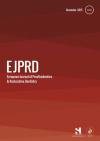European Journal of Prosthodontics and Restorative Dentistry
The Effect of Disinfection Techniques on the Flexural Strength of Thermopolymerisable Acrylic Resins With or Without Pigment Addition
Abstract
The Effect of Disinfection Techniques on the Flexural Strength of Thermopolymerisable Acrylic Resins With or Without Pigment Addition
Marcelo Coelho Goiato, Bruna Carolina Rossatti Zuccolotti, Marcela Filié Haddad, Amália Moreno, Aldiéris Alves Pesqueira, Humberto Gennari Filho, Daniela Micheline dos Santos
ABSTRACT
Objectives: The aim of this study was to assess the flexural strength of two brands of thermopolymerisable acrylic resins (Onda Cryl, Artigos Odontológicos Clássico Ltda, São Paulo, SP, Brazil; and Lucitone 550, Dentsply, York, PA, USA) with varying concentrations of pigment (Poli-Côr, Artigos Odontológicos Clássico Ltda, São Paulo,SP, Brazil)
under the influence of thermocycling, storage and disinfection.
Material and Methods: A total of 210 samples were manufactured (105 for each acrylic resin brand), with dimensions of 64 x 10 x 3.3 mm. The samples were divided into 30 subgroups (n=7) according to the proportion of pigment used (without pigment, 3% and 7%), the assessment period (initial or thermocycling for 2000 cycles) and disinfection
method (immersion in 1% sodium hypochlorite, (Apothicário, Araçatuba, SP, Brazil), microwave energy or immersion in alkaline peroxide (Efferdent, Pfizer, Morris Plains, NJ, USA). The samples were submitted to the flexural strength test before and after thermocycling, and after storage with disinfection. The disinfection process was performed every 3 days, for 60 days. Data were submitted to analysis of variance (ANOVA) and Tukey test (p<0.05).
Results: The factors that provided statistical alteration in flexural strength values were resin type and assessment period. The Onda Cryl resin and the period after disinfection (126 ± 25 MPa) exhibited the higher values of flexural strength.
Conclusion: Following disinfection, Onda-Cryl resin exhibited the highest values of flexural strength.
All the samples obtained are considered clinically acceptable.
Keywords
Acrylic Resins
Color Stability
Flexural Strength
Authors
Marcelo Coelho Goiato, Bruna Carolina Rossatti Zuccolotti, Marcela Filié Haddad, Amália Moreno, Aldiéris Alves Pesqueira, Humberto Gennari Filho, Daniela Micheline dos Santos
Articles from this issue
 Free Access
Free Access No Access
No Access Full Access
Full Access


